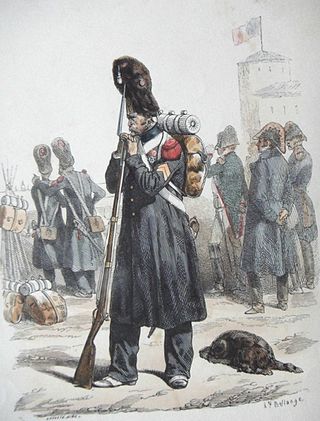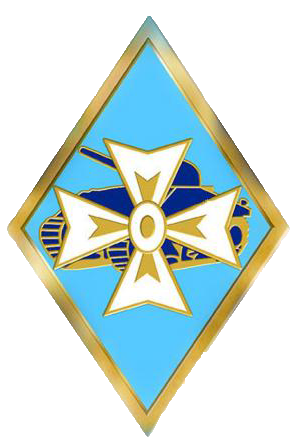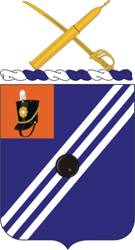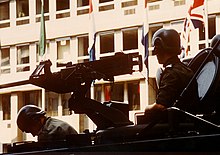
The Imperial Guard was an elite guard formation of the French Imperial Army under the direct command of Napoleon. Expanding considerably over time, the formation acted as his bodyguard and tactical reserve, and he was careful of its use in battle. The Imperial Guard was divided into a general staff and infantry, cavalry and artillery regiments as well as battalions of sappers and marines. It distinguished between experienced veterans and less experienced members by being separated into three sections: the Old Guard, Middle Guard and Young Guard. The Young Guard was virtually annihilated in the Battle of Krasnoi during the French invasion of Russia.

The Land Component, historically and commonly still referred to as the Belgian Army, is the land branch of the Belgian Armed Forces. The King of the Belgians is the commander in chief. The current chief of staff of the Land Component is Major-General Jean-Pol Baugnée.
The 19th Army Corps was a corps of the French army. In December 1870, the Tours delegation created the 19th Army Corps which was formed in Alençon. It was recreated by decree of the JO of August 13, 1874, it brought together the various military units of Algeria. It constituted the nucleus of the Army of Africa.

The 1st Free French Division was one of the principal units of the Free French Forces (FFL) during World War II, renowned for having fought the Battle of Bir Hakeim.

The 1st Armored Division is a unit of the French Army formed during World War II that took part in the Liberation of France.

The 1st Marine Infantry Regiment is a French regiment heir of the colonial infantry. The regiment is one of the quatre vieux regiments of the Troupes de Marine, with the 2nd Marine Infantry Regiment 2e RIMa, the 3rd Marine Infantry Regiment 3e RIMa, as well the 4th Marine Infantry Regiment 4e RIMa. Along with the 1st Marine Artillery Regiment 1er RAMa and the 2nd Marine Artillery Regiment 2e RAMa, the 1st Marine formed the Blue Division. The 1er RIMa is a light armoured unit, since 1986, alike with the régiment d'infanterie-chars de marine RICM.

The 1st Marine Artillery Regiment is one of the oldest marine artillery units in the military of France, as part of the troupes de marine within the French Army {Founded 1692}.

The 11th Marine Artillery Regiment (France) (French: 11e Régiment d'Artillerie de Marine, 11e RAMa) is an artillery regiment of the French Army. The regiment constitutes the fire support unit of the 9th Marine Infantry Brigade. The regiment employs around 950 men, fielding TRF1 155mm howitzers and MO-120-RT-61 120mm mortars. The regiment was founded in a third operational phase in 1951.

The 5th Field Artillery Regiment was constituted as part of the Regular Army in January 1907. Individual battalions have lineages which date back further. Currently, it is a parent regiment under the U.S. Army Regimental System, with a single active battalion, the 1st Battalion, 5th Field Artillery, which is assigned to the 1st Brigade Combat Team, 1st Infantry Division at Fort Riley, Kansas.

The 6th Foreign Infantry Regiment was an infantry regiment of the Foreign Legion in the French Army from 1939 to 1941 and again from 1949 to 1955.

The 319th Field Artillery Regiment, more commonly referred to as the 319th Airborne Field Artillery Regiment, is a parent regiment in the U.S. Army Regimental System. Four battalions of the regiment are currently active. The first three battalions 1st Battalion, 319th Field Artillery Regiment, 2nd Battalion, 319th Field Artillery Regiment, 3rd Battalion, 319th Field Artillery Regiment are in the 82nd Airborne Division and the 4th Battalion, 319th Field Artillery Regiment is in the 173rd Airborne Brigade.

The 6th Field Artillery Regiment is a Field Artillery Branch regiment of the United States Army first activated in 1907 from numbered companies of artillery. It was first organized with two battalions.

The 32nd Field Artillery Regiment is a distinguished and highly decorated field artillery regiment of the United States Army, first Constituted in 1918.
The 377th Field Artillery Regiment is a field artillery regiment of the United States Army. A parent regiment under the U.S. Army Regimental System, the regiment's 2nd Battalion, 377th Field Artillery Regiment is assigned to the 2nd Infantry Brigade Combat Team (Airborne), 11th Airborne Division. Elements of the regiment have also served with the 101st Airborne Division and 82nd Airborne Division, and have seen service in World War II, Vietnam, and in both Iraq and Afghanistan during the Global War on Terror. The 1st and 3rd Battalions as well as Batteries D and E are Inactive.

The Army of Châlons was a French military formation that fought during the Franco-Prussian War of 1870. Formed in the camp of Châlons on August 17, 1870, from elements of the Army of the Rhine which the formation was issued from, the Army of Châlons was engaged in combats of Beaumont and Sedan while disappearing during the capitulation of September 2, 1870.

The 1st Battalion, 108th Field Artillery Regiment, 56th Stryker Brigade Combat Team, is the only direct support field artillery battalion in the only National Guard Stryker Brigade in the United States Army.

The 101st Airborne Division Artillery (DIVARTY) is the force fires headquarters for the 101st Airborne Division at Fort Campbell, Kentucky. The DIVARTY has served with the division in World War II, Vietnam, Operations Desert Shield and Storm, Operation Iraqi Freedom, and in peacetime at Camp Breckinridge and Fort Campbell, Kentucky, and Fort Jackson, South Carolina. The DIVARTY was inactivated in 2005 as part of transformation to modular brigade combat teams, but was reactivated on 16 October 2014 to provide fire support coordination and mission command for the training and readiness of field artillery units across the division.
The Order of battle, Keren 1941 shows Italian army forces that participated in the Battle of Keren from February to March 1941 and British troops in Sudan on 20 January 1941, which participated in military operations against Eritrea during the East African Campaign 1940–1941.
The Division Daguet was a French Army division formed in September 1990 in Saudi Arabia as part of France's contribution to Operation Desert Shield. The French military contribution to the allied cause to liberate Kuwait from Iraqi occupation was named Opération Daguet and its ground part was subsequently named Division Daguet. In French "Daguet" is a young brocket deer.

The 1st Battalion, 76th Field Artillery Regiment is an inactive field artillery battalion of the United States Army. The battalion has been assigned to the 3rd Infantry Division, 7th Infantry Division, 2nd Infantry Brigade, and as a separate field artillery battalion. The battalion has participated in World War I, World War II, Operation Iraqi Freedom, and Operation Enduring Freedom. The battalion inactivated in 2015 as part of Army force reductions.



















